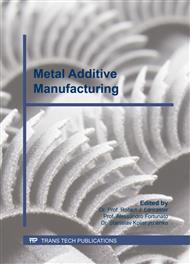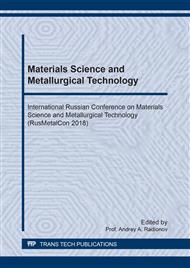[1]
F. Arias-González, J. D. Val, R. Comesaña, J. Penide, F. Lusquiños, F. Quintero, A. Riveiro, M. Boutinguiza, F. J. Gil, J. Pou. Microstructure and crystallographic texture of pure titanium parts generated by laser additive manufacturing, Metals and Materials International. 24 (1) (2018) 231-239.
DOI: 10.1007/s12540-017-7094-x
Google Scholar
[2]
Y. Zhang, L. Wu, X. Guo, S. Kane, Y. Deng, Y. G. JungJe, H. Lee, J. Zhang. Additive Manufacturing of Metallic Materials, Journal of Materials Engineering and Performance. 27 (1), (2018) 1-13.
Google Scholar
[3]
C. Han, Y. Li, Q. Wang, S. Wen, Q. Wei, C. Yan, L. Hao, J. Liu, Y. Shi. Continuous functionally graded porous titanium scaffolds manufactured by selective laser melting for bone implants, Journal of the Mechanical Behavior of Biomedical Materials. 80, (2018) 119-127.
DOI: 10.1016/j.jmbbm.2018.01.013
Google Scholar
[4]
Yu.N. Loginov, A.I. Golodnov, S.I. Stepanov, E.Yu. Kovalev. Determining the Young's modulus of a cellular titanium implant by FEM simulation, AIP Conference Proceedings. 1915 (2017) 030010.
DOI: 10.1063/1.5017330
Google Scholar
[5]
B. Piotrowski, A.A. Baptista, E. Patoor, P. Bravetti, A. Eberhardt, P. Laheurte. Interaction of bone-dental implant with new ultralow modulus alloy using a numerical approach, Materials Science and Engineering. C 38 (2014) 151-160.
DOI: 10.1016/j.msec.2014.01.048
Google Scholar
[6]
K. Moiduddin, Microstructure and mechanical properties of porous titanium structures fabricated by electron beam melting for cranial implants, Proceedings of the Institution of Mechanical Engineers, Part H: Journal of Engineering in Medicine. (2018) 185-199.
DOI: 10.1177/0954411917751558
Google Scholar
[7]
W. Xue, B.V. Krishna, A. Bandyopadhyay, S. Bose. Processing and biocompatibility evaluation of laser processed porous titanium, Acta Biomaterialia. (2007) 1007-1018.
DOI: 10.1016/j.actbio.2007.05.009
Google Scholar
[8]
Y. Loginov, S. Stepanov, C. Khanykova. Inhomogeneity of deformed state during compression testing of titanium implant, MATEC Web of Conferences. 132, (2017) 03009.
DOI: 10.1051/matecconf/201713203009
Google Scholar
[9]
Y.N. Loginov, S.I. Stepanov, E.V. Khanykova. Effect of pore architecture of titanium implants on stress-strain state upon compression, Solid State Phenomena. 265 (2017) 606-610.
DOI: 10.4028/www.scientific.net/ssp.265.606
Google Scholar
[10]
Y.N. Loginov, V.D. Solovei, V.V. Kotov. Transformation of the yielding condition during the deformation of hcp metallic materials. Russian Metallurgy (Metally). 3 (2010) 235-240.
DOI: 10.1134/s0036029510030146
Google Scholar
[11]
Y.N. Loginov, M.P. Puzanov. Finite element modeling of the upsetting of an anisotropic cylindrical workpiece, AIP Conference Proceedings. 1915 (2017) 040033.
DOI: 10.1063/1.5017381
Google Scholar
[12]
Mechanical testing of metals. Ductility testing. Compression test for porous and cellular metals ISO 13314:2011. International Organization for Standartization (2011).
DOI: 10.3403/30203544
Google Scholar
[13]
S. Broxtermann, M. Taherishargh, I.V. Belova, G.E. Murch, T.Fiedler. On the compressive behaviour of high porosity expanded Perlite-Metal Syntactic Foam (P-MSF), Journal of Alloys and Compounds. 691 (2017) 690-697.
DOI: 10.1016/j.jallcom.2016.08.284
Google Scholar
[14]
J. Liu, J. Yang. Investigation of Mesh Independency of Micro Polar Constitutive Model by Modelling Saturated Porous Media in Biaxial Tests, Poromechanics. 2017. - Proceedings of the 6th Biot Conference on Poromechanics. (2017) 1827-1835.
DOI: 10.1061/9780784480779.226
Google Scholar
[15]
M. Nesládek, M. Španiel. An Abaqus plugin for fatigue predictions. Advances in Engineering Software. 103 (2017) 1-11.
DOI: 10.1016/j.advengsoft.2016.10.008
Google Scholar
[16]
M. Würkner, S. Duczek, H. Berger, H. Köppe, U. Gabbert. A software platform for the analysis of porous die-cast parts using the finite cell method, Adv. Structured Materials. 81 (2018) 327-341.
DOI: 10.1007/978-981-10-6895-9_14
Google Scholar
[17]
B.Y. Su, C.M. Huang, H. Sheng, W.Y. Jang. The effect of cell-size dispersity on the mechanical properties of closed-cell aluminum foam, Materials Characterization. 135 (2018) 203-213.
DOI: 10.1016/j.matchar.2017.11.035
Google Scholar
[18]
F. Li, J. Li, H. Kou, L. Zhou. Porous Ti6Al4V alloys with enhanced normalized fatigue strength for biomedical applications, Materials Science and Engineering. C 60 (2016) 485-488.
DOI: 10.1016/j.msec.2015.11.074
Google Scholar
[19]
C. Cosma, N. Balc, M. Moldovan, L. Morovic, P. Gogola, C. Miron-Borzan, Post-processing of customized implants made by laser beam melting from pure titanium, J. of Optoelectronics and Advanced Materials. 19 (2017) 738-747.
Google Scholar
[20]
H. Shen, H. Li, L.C. Brinson. Effect of microstructural configurations on the mechanical responses of porous titanium: A numerical design of experiment analysis for orthopedic applications, Mechanics of Materials. 40 (9) (2008) 708-720.
DOI: 10.1016/j.mechmat.2008.03.009
Google Scholar
[21]
W. Seo, D. Jeong, D. Lee, H. Sung, Y. Kwon, S. Kim, Effects of cooling rate and stabilization annealing on fatigue behavior of β-processed Ti-6Al-4V alloys, Metals and Materials International. 23 (2017) 648-659.
DOI: 10.1007/s12540-017-6730-9
Google Scholar
[22]
A.A. Popov, A.G. Illarionov, S.I. Stepanov, O.A. Elkina, O.M. Ivasishin, Effect of quenching temperature on structure and properties of titanium alloy: Structure and phase composition, Physics of Metals and Metallography. 115 (2014) 507-516.
DOI: 10.1134/s0031918x14050068
Google Scholar



